Stir fry for flavourful, colourful greens
View(s):By Dr. Nirmala M. Pieris
Stir frying is a cooking technique in which ingredients are fried in a small amount of very hot oil while being stirred in a wok or a frying pan. This is a great way to keep in maximum nutrients, sealing the flavour and preserving the colour and texture. In Sri Lanka this cooking method is commonly called ‘tel dala’.
To stir fry, heat oil, add onions, garlic and if you are making a side dish for Sri Lanka cuisine, some curry powder, chillie and maldive fish flakes and then the washed torn or chopped leaves in large chunks along with finely sliced stems. Toss up for a few minutes until heated right through and add salt to taste. If you are making an accompaniment to Chinese cuisine, add sauces such as soya, fish or oyster instead of the curry powder and maldive fish. Always keep everything moving around in the pan and do not overcook.
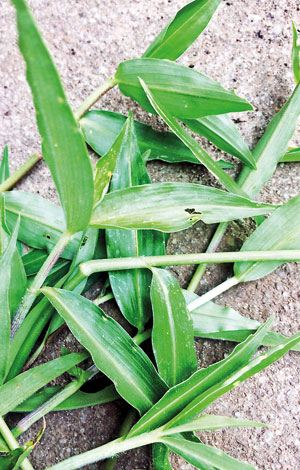 Gira Pala
Gira Pala
Gira pala, Commelina diffusa in the family Commelinaceae sometimes known as climbing dayflower is mostly seen in moist places. The common name is appropriate since each flower that is bright blue blooms for only one day. The plant spreads diffusely, creeping along the ground, branching heavily and rooting at the nodes. The leaves are bright green and alternate with narrow to broadly lance-shaped leaf blades and leaf sheaths that wrap the stems. The young leaves have diuretic effects.
 Bathala
Bathala
Bathala, sweet potato, Ipomea batatas, in the family Convolvulaceae is a tuberous root vegetable. The leaves are an excellent source of antioxidants and contain high levels of vitamin A, C and B group vitamins. They also contain impressive amounts of fibre and a range of minerals that includes calcium, potassium and iron. The leaves are rich in anthocyanin and beta-carotene that helps protect the liver and reduces chances of liver injury. It also controls blood sugar naturally and exhibits anti-hypertension activity while promoting bowel movements and relieving constipation. Bathala leaves stir fry is a popular dish in Chinese cuisine.
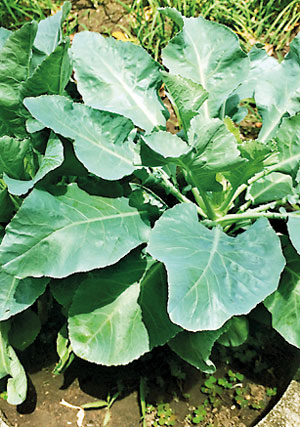 Cauliflower
Cauliflower
Cauliflower, Brassica oleracea variety botrytis in the family Brassicaceae bears a large flower head of small creamy-white flower buds. The leaves that surround the flower head are rich in calcium and iron and are one of the richest sources of calcium in vegetables and have several health benefits ranging for healthy bones to better immunity. For those who are lactose intolerant or are unable to incorporate milk and dairy products in their diets, cauliflower leaves are a great source of calcium. The leaves are also rich in fibre,aid digestion and keep the gut healthy. Cauliflower leaves can also be used for mallung.
 Broccoli
Broccoli
Broccoli, Brassica oleracea variety italica in the family Brassicaceae has a large flowering head that is eaten as a vegetable. Broccoli leaves are an excellent source of carotenoids and vitamin A which is several times greater than that in their flower-heads. Leaves are a richer source of beta-carotene than either the stems or the florets. The stems have a mild sweet flavour and are much higher in fibre than the florets. The leaves also contain vitamin C, a nice dose of calcium and glucosinolates that aid in detoxification and lower the risk of certain types of cancers. The leaves also make a good mallung.
 Chili
Chili
Chili, Capsicum annuum in the family Solanaceae has a large number of varieties. Chili leaves contain a complete range of amino acid almost four times compared to the fruits. It also contains more than double what chili fruits have of which are anti-cancerous substances. Chili leaves are rich in calcium, beta carotene, various vitamins and other nutrients. Eating a suitable quantity of chili leaves enhances secretion of digestive juices, improves appetite and is good for indigestion, gastric and stomach discomfort. Chili leaves can either be stir fried by itself or added to meats, fish or when making soup.
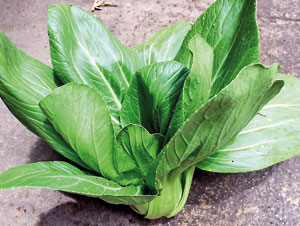 Bok Choy
Bok Choy
Bok Choy or Pak Choi, Brassica rapasub species chinensis in the family Brassicaceae is a low calorie vegetable recommended in weight reduction programmes.It is an excellent source of vitamins C, A and K and a good source of B-complex vitamins. Vitamin-K makes bones stronger and delays osteoporosis. The leaves also contain anti-oxidants and dietary fibre that help protect against breast, colon, and prostate cancers and reduce LDL or “bad cholesterol” levels in the blood. Further, the leaf is a moderate source of minerals, including those that help regulate heart rate and blood pressure. Bok choy commonly appears in Chinese menus.
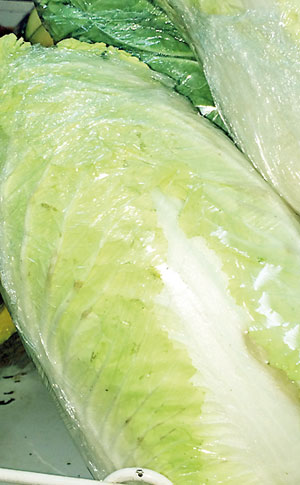 Napa Cabbage
Napa Cabbage
Napa cabbage, Brassica rapa sub species pekinensis in the family Brassicaceae is an oblong shaped head consisting of tightly arranged crinkly, thick, light-green leaves with prominent, pale white veins. It is incredibly low in calories and easily fits into the zero calorie group of vegetables. Napa is packed with antioxidants and is an abundant source of dietary fibre and helps reduce LDL or “bad cholesterol” levels in the blood. It is also an excellent source of folates and has good levels of vitamin C that helps the body develop resistance against infections.
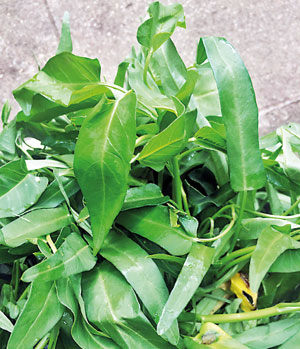 Kankung
Kankung
Kankung, Ipomoea aquatica in the family Convolvulaceae is a semi-aquatic plant. The leaves are an excellent source of dietary fibre, protein, calcium, iron, vitamin A and C. It is an excellent option for those individuals who want to lose weight and reduce cholesterol naturally. Being rich in iron, the young leaves are extremely beneficial for anemia and pregnant women. The vitamin A in the leaf is good for eye health. The antioxidants in the leaf, prevents free radical damage of cells in the body,making skin cells more resistant to damage from sun exposure and minimizing wrinkling. The leaves are also used for mallung.
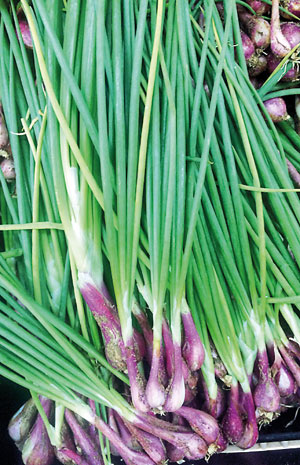 Luunu Kola
Luunu Kola
Luunu kola, Spring onion, Allium fistulosum, in the family Amaryllidaceae are in fact very young onions, harvested before the bulb has had a chance to swell. Both the long, slender green tops and the small bulbs are edible and have the benefits of both onions and greens. They are a rich source of vitamin A, C, and K and are high in fibre, minerals and contain sulfur compounds which inhibit fungal infections. It also lowers blood sugar levels, decreases cholesterol and blood pressure levels and speeds up the level of blood circulation in the body.
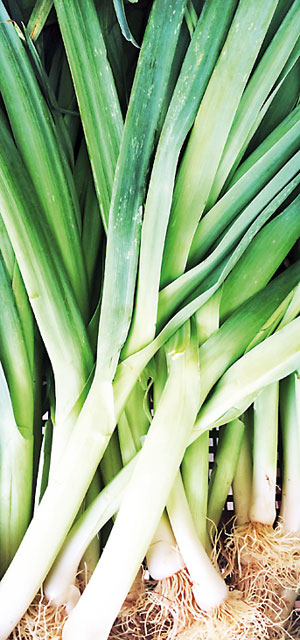 Leeks
Leeks
Leeks, Allium porrum in the family Amaryllidaceae contain good amounts of the flavonoid kaempferol, which protects blood vessel linings from damage and important concentrations of the B vitamin folate that supports the cardiovascular system. Leeks is one of the few foods that contain prebiotics, a type of good bacteria, necessary for better nutrient absorption. It is also a rich source of calcium and magnesium that is essential for bone health. Due to its iron content, leeks can also help in preventing various types of anemia. It is also rich in vitamin C, which can help in better absorption of iron in the body.
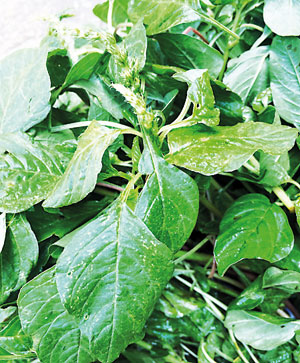 Tampala
Tampala
Tampala, Amaranth species in the family Amaranthaceae shows a wide variety of morphological diversity among and even within certain species. The leaves of varieties of edible tampala can range from whitish green to green to red and are commonly called, kura tampala, katu tampala, sudu tampala and rathu tampala that have mildly different flavours. Packed with antioxidants, protein, vitamins, calcium, carbohydrates, iron, fibre and minerals, the benefits of the leaves include the maintenance of proper mineral balance in the body, lowering of cholesterol levels, reducing risk of osteoporosis, improving digestion and providing an energy boost.
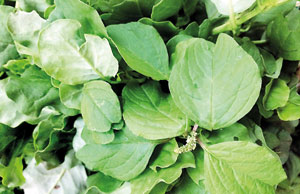 Sarana
Sarana
Sarana, is of two types, maha sarana and heen sarana, Trianthema portulacastrum in the family Aizoaceaeis an annual herb with a firm tap root with ascending or prostrate stems that are loosely mat forming.The stems can be up to a metre long. The leaves are sub-fleshy and are a good source of fibre, proteins, riboflavin, potassium, sodium and iron.The leaves are diuretic and useful to combat fluid retention in the body that causes swelling of the feet and ankles. They also have laxative properties and help regulate menstruation.
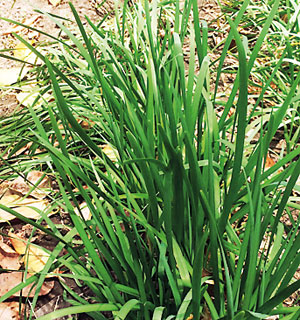 Nira Leeks
Nira Leeks
Nira leeks or Chinese leeks also called garlic chives Allium tuberosum in the family Amaryllidaceae has flat and dark green leaves with a mild taste between the garlic and onion. Nira leeks are high in vitamin C and rich in vitamins A, B, iron, calcium and magnesium. They are also rich in cellulose and promote intestinal peristalsis, resisting the occurrence of colorectal cancer, while reducing the absorption of cholesterol. Like other members of the garlic and onion family, nira leeks contain a sulphur-rich compound that aids digestion and helps promote the flow of blood.
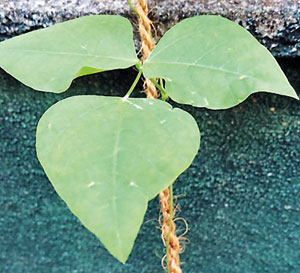 Dambala
Dambala
Dambala, winged bean, Psopho-carpustetra-gonolobus in the family Fabaceae is a twining annual vine. All parts of the plant including pods, seeds, tender leaves and shoots, flowers and tubers are edible.Dambala leaves are an excellent source of fibre, vitamin C, A, calcium and iron. It is also a good source of proteins, vitamin B6 and zinc. These vitamins and minerals play a significant role by endowing the body with powers to fight diseases, maintain cardiovascular health and also assist in collagen production, development and maintenance of blood vessels and making bones stronger.
Other leaves used for Stir frying
Genda, Gotukola , Beetroot Greens, Cabbage, Kale, Kathurumurunga, Knol Kohl, Mukunuwenna, Murunga and Rabu are also used for stir fries.


